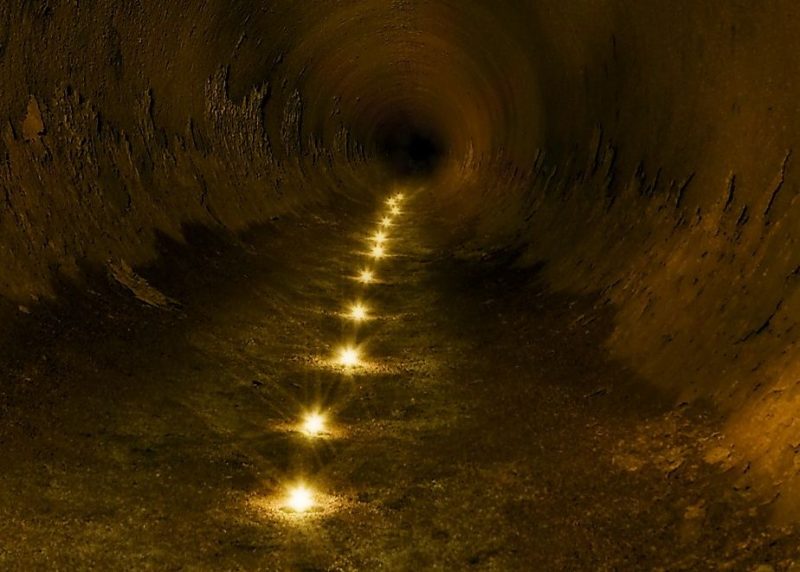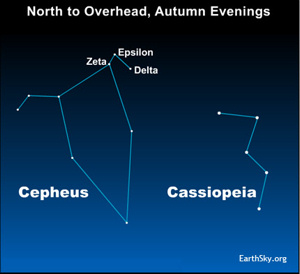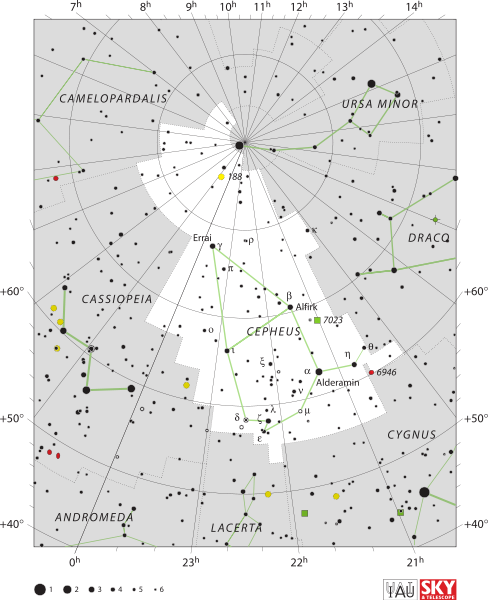![]()

Like lights in a dark tunnel, stars in the distant universe become fainter as they are farther away. Because they pulsate at a rate correlated to their own intrinsic brightnesses, Cepheid variable stars reveal their own true distances. Image via The Last Word on Nothing
At the southeast corner of the house-shaped constellation Cepheus the King, there’s an intriguing variable star called Delta Cephei. With clocklike precison, this rather faint star doubles in brightness, fades to a minimum and then doubles in brightness every 5.36 days. You can see it change over a period of days. The entire cycle is visible to the eye alone in a dark-enough sky. This star and others like it have secured a place as important standard candles for establishing the scale of the galaxy and universe.
Delta Cephei itself looms large in the history of astronomy. An entire class of supergiant stars – called Cepheid variables – is named in this star’s honor.
Like Delta Cephei, Cepheid variable stars dependably change their brightnesses over regular intervals. The time period can range from about one to 100 days, depending on the star’s luminosity or intrinsic brightness. Astronomers have learned that – the longer the cycle – the greater the intrinsic brightness of the star. This knowledge is a powerful tool in astronomy for probing distances across vast space.

This graph – measuring brightness variations over time – is what astronomers call a light curve. It’s the light curve of Delta Cephei, which, as dependably as a fine clock, doubles in brightness and then fades again every 5.366341 days.
How do Cepheid variable stars help measure cosmic distances? Because Delta Cephei and other stars in its class vary so dependably – and because the cycle of their brightness change is tied so strongly to their intrinsic brightnesses – these stars can be used to measure distances across space. Astronomers call objects that can be used in this way standard candles.
How does it work? First, astronomers carefully measure the rates of these stars’ pulsations. Unfortunately, the distances to very few – if any – Cepheid variable stars are close enough to measure directly by stellar parallax. However, the approximate distances of Cepheid variables in relatively nearby star clusters have been determined indirectly by the spectroscopic method (sometimes called by the misnomer spectroscopic parallax). After watching many Cepheid variables pulsate – and knowing their approximate distances via the spectroscopic method – they know how bright a Cepheid variable of a particular intrinsic brightness should look at a given distance from Earth.
Armed with this knowledge, astronomers watch the pulsations of this class of stars in distant space. They can deduce the stars’ intrinsic brightnesses because of their rates of pulsation. Then they can infer the distances to more faraway stars by their apparent magnitude. Because light dims by the inverse square law, astronomers know a star of a given luminosity (intrinsic brightness) would appear 1/16th as bright at four times the distance, 1/64th as bright at eight times the distance or 1/100th as bright at 10 times the distance.
Why are these stars varying in brightness, by the way? The variations are thought to be actual pulsations as the star itself expands and then contracts.
Cepheid variable stars can be seen up to a distance of 20 million light-years. The nearest galaxy is about 2 million light-years away – and the most distant are billions of light-years away. So these stars don’t get you far in measuring distances across space. Still, since astronomers learned the secrets of their pulsation, these stars have been vital to astronomy.
The astronomer Henrietta Leavitt discovered Cepheid variables in 1912. In 1923, the astronomer Edwin Hubble used Cepheid variable stars to determine that the so-called Andromeda nebula is actually a giant galaxy lying beyond the confines of our Milky Way. That knowledge released us from the confines of a single galaxy and gave us the vast universe we know today.
How can I spot Delta Cephei in the night sky? This star is circumpolar – always above the horizon – in the northern half of the United States.
Even so, this star is much easier to see when it’s high in the northern sky on autumn and winter evenings. You can find Cepheus by way of the Big Dipper. First, use the Big Dipper “pointer stars” to locate Polaris, the North Star. Then jump beyond Polaris by a fist-width to land on Cepheus.
You’ll see the constellation Cepheus the King close to his wife, Cassiopeia the Queen, her signature W or M-shaped figure of stars making her the flashier of the two constellations. They’re high in your northern sky on November and December evenings.
How can I watch Delta Cephei vary in brightness? The real answer to that question is: time and patience. But two stars lodging near Delta Cephei on the sky’s dome – Epsilon Cephei and Zeta Cephei – match the low and high ends of Delta Cephei’s brightness scale. That fact should help you watch Delta Cephei change.
So look back at the charts above, and locate the stars Epsilon and Zeta Cephei. At its faintest, Delta Cephei is as dim as the fainter star, Epsilon Cephei. At its brightest, Delta Cephei matches the brightness of the brighter star, Zeta Cephei.
Have fun!
Enjoying EarthSky? Sign up for our free daily newsletter today!
Bottom line: The star Delta Cephei brightens and fades with clocklike precision every 5.36 days. The rate of brightness change is tied to the star’s intrinsic brightness. That’s how a whole class of stars named for Delta Cephei – called Cepheid variable stars – helps astronomers measure distances.
Source:
https://earthsky.org/brightest-stars/delta-cephei-the-kings-famous-variable-star

